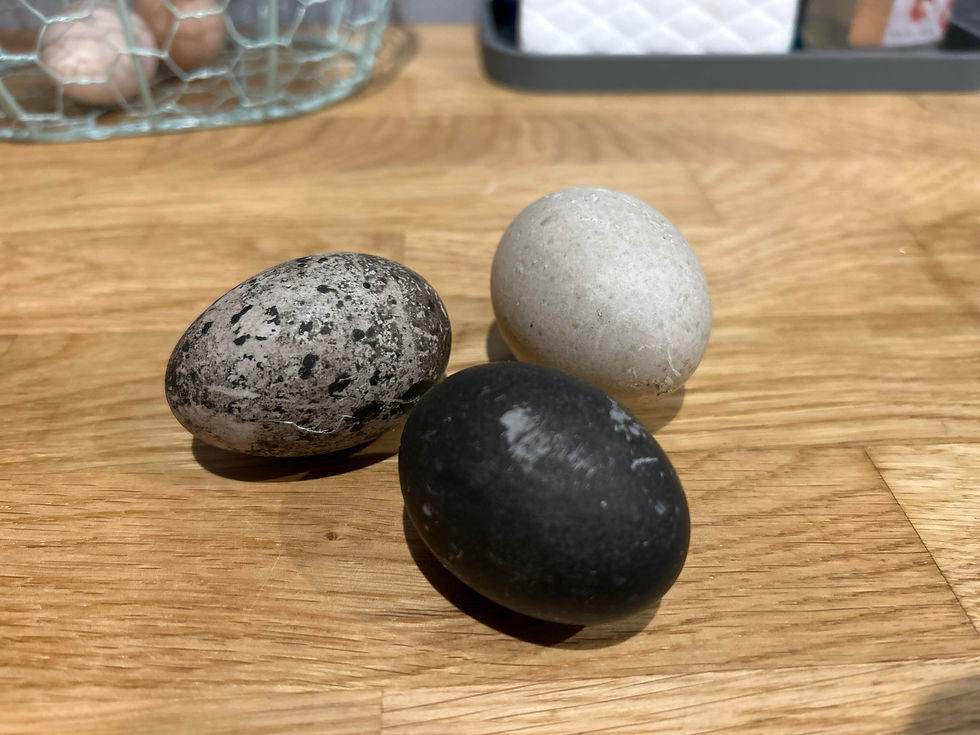All About the Cayuga Duck
- Annie

- 5 days ago
- 3 min read

I still remember the day I fell down a Google rabbit hole searching for unique egg colors to diversify my egg basket. When I discovered black eggs, I was convinced someone was joking. But it led me straight to the beautiful Cayuga duck, a breed known for laying those stunning dark eggs.
Now, I never ended up adding ducks to our flock (as much as the kids begged!), but I did learn a LOT about this fascinating waterfowl. And if you’re thinking about adding variety to your backyard flock here in Minnesota or anywhere else in the Midwest, Cayugas deserve a serious look.
What Makes the Cayuga Duck So Unique
Cayuga ducks are showstoppers. Their glossy, iridescent black feathers shimmer green and blue in the sunlight, making them one of the most striking duck breeds you can raise.
A few standout features:
Jet-black or slate-colored bill
Orange to dark-washed legs
Slightly arched neck
Broad, sturdy body
Most ducks I’ve owned over the years were white and loud and loved to strut around the yard like they owned the place. Knowing what I know now, I might have given Cayugas a try first!
History of the Cayuga Duck
The Cayuga duck is actually an American breed, first developed in the mid-1800s in Cayuga County, New York. It’s believed to descend from the American Black Duck, which explains the dark coloring and hardy nature.
They were originally kept for:
Their striking appearance
Meat production
Dependable egg laying
Today, they’re beloved by backyard farmers, hobbyists and homesteaders all over the U.S.
Cayuga Duck Temperament
If you want a duck that’s sweet, gentle and social, the Cayuga is a great choice. They adapt well to mixed flocks, get along with other ducks and poultry and love to forage.
We’ve had chickens, geese and ducks all at once in the past, and while I personally prefer chickens (ducks are FUN but messy!), many families make mixed flocks work beautifully. It really depends on your setup.
Do Cayuga Ducks Lay Black Eggs?
Yes! But only early in the season.
100–180 eggs per year
Medium-sized
Start out very dark black
Gradually lighten to gray or white as the season goes on

Even if you’re raising ducks in colder climates like Minnesota, South Dakota or Wisconsin, Cayugas tend to lay consistently when well cared for.
Housing, Space and Water Requirements
Like all ducks, Cayugas thrive when they have:
Clean water for swimming, dabbling and washing their faces
Safe shelter from predators
Dry bedding
Outdoor space to forage and explore
My biggest challenge when we had ducks was winter water access. If you live in a cold region, make a plan for:
A heated water dish
A safe, shallow tub that can be dumped daily
Extra bedding for traction and warmth
It’s definitely doable to have ducks in cold places, it just takes a little planning!
What They Eat and What Helps Them Thrive
A balanced waterfowl feed is essential for duck health and egg production. You can also safely add:
Fresh greens
Peas
Corn
Mealworms
Garden scraps (duck-safe only)
And here’s something many people don’t know Strong Animals Chicken Essentials products are safe for ducks too!
Common Cayuga Duck Health Concerns
Cayugas are hardy, but regular checks help prevent:
External parasites (harder to see on black feathers)
Respiratory issues from wet bedding
Nutritional deficiencies
Foot problems from slippery surfaces
Doing quick weekly health checks and offering clean water daily goes a long way.
Should You Add Cayugas to Your Backyard Flock?
If I ever added waterfowl again, I’d absolutely consider Cayugas. They’re beautiful, friendly, unique and pretty easy to manage once you have the right setup.
Just… don’t tell the kids I’m entertaining the idea again. Haha!
Until next time,
– The Wing Lady




